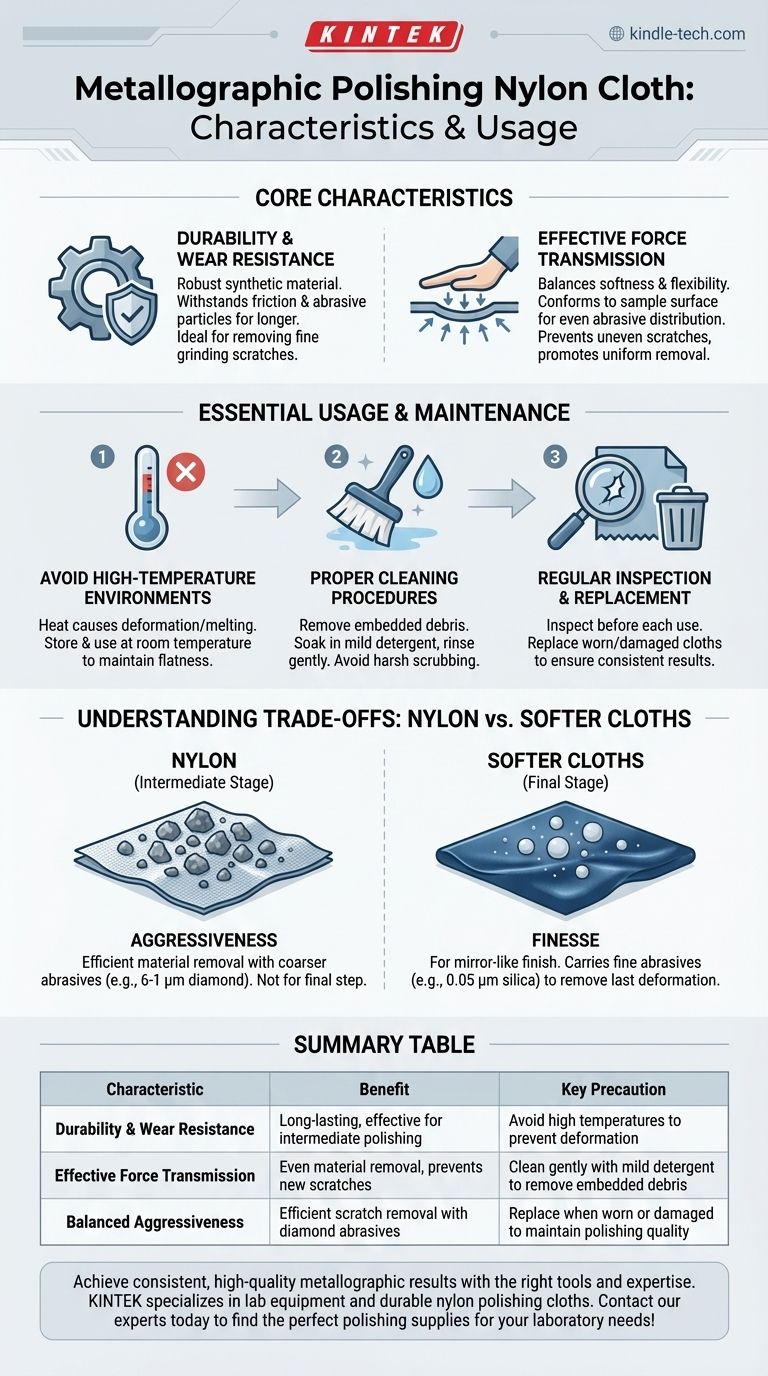In metallographic polishing, nylon cloth is prized for its excellent wear resistance and durability. It provides a crucial balance of softness for even force distribution and toughness for effective material removal, particularly during intermediate polishing stages. Proper care involves avoiding high temperatures, cleaning gently with mild detergents, and replacing it periodically or when damaged to ensure consistent, high-quality sample finishes.
The core challenge in sample preparation is balancing efficient material removal with a flawless surface finish. Nylon cloth is the workhorse for the intermediate stages, but understanding its role in a sequential process—followed by softer cloths—is the key to achieving a truly mirror-like, artifact-free surface for analysis.

Core Characteristics of Nylon Polishing Cloth
Nylon polishing cloths are a staple in materials science labs due to their specific physical properties that make them ideal for certain steps in the metallographic preparation process.
Durability and Wear Resistance
Nylon is a robust synthetic material. This inherent toughness means the cloth can withstand the friction and abrasive particles used in polishing for longer periods than more delicate cloths.
This makes it highly effective for removing the fine scratches left behind by the final grinding stages, preparing the surface for final polishing.
Effective Force Transmission
While durable, nylon cloth also has sufficient softness and flexibility. This allows it to conform to the sample's surface, ensuring the polishing abrasive is distributed evenly.
This even transmission of force prevents the creation of new, uneven scratches and promotes a uniform material removal rate across the entire specimen.
Essential Usage and Maintenance Protocols
Proper handling and maintenance are not optional; they are critical for achieving repeatable results and protecting your samples from damage.
Avoiding High-Temperature Environments
Nylon is a thermoplastic polymer. Exposing the cloth to high heat can cause its fibers to deform, melt, or harden.
A deformed polishing surface will no longer be flat, leading to uneven polishing and potentially ruining the sample's planarity. Always store and use the cloths at room temperature.
Proper Cleaning Procedures
Over time, abrasive particles and sample debris can become embedded in the cloth, reducing its effectiveness and potentially causing scratches.
For stubborn residue, the cloth can be soaked in a mild detergent and gently rinsed. Avoid harsh scrubbing, which can damage the cloth's texture.
Regular Inspection and Replacement
A worn or damaged cloth is a primary source of polishing failures. You must inspect the cloth before each use for signs of tearing, contamination, or glazing (a smooth, worn-down surface).
Replace the cloth periodically as part of a standard lab protocol, and immediately if any damage is found. This discipline is essential for maintaining polishing effectiveness.
Understanding the Trade-offs: Nylon vs. Softer Cloths
No single polishing cloth is suitable for the entire process. Choosing the right cloth for the right stage is fundamental to success.
Aggressiveness vs. Finesse
Nylon's durability makes it more aggressive than final-polishing cloths. It is designed for efficient material removal with coarser abrasives (e.g., 6 to 1-micron diamond suspensions).
While it creates a very good surface, it is generally not used for the final step, as it may still impart very fine, minute scratches of its own.
The Role of Final Polishing Cloths
For the final, mirror-like finish, technicians switch to much softer, low-nap or napped cloths, such as silk or velvet. These cloths are far more delicate and less durable.
Their purpose is not significant material removal but to carry a very fine abrasive (e.g., 0.05-micron colloidal silica or alumina) to gently remove the last traces of deformation, revealing the true microstructure without introducing new scratches.
Making the Right Choice for Your Process
Selecting and maintaining your polishing cloth directly impacts the quality of your microstructural analysis. Base your decisions on the specific stage of your workflow.
- If your primary focus is intermediate polishing: Use nylon cloth for its durability and efficient removal of fine grinding scratches with diamond abrasives.
- If your primary focus is achieving a final, mirror-like finish: Transition from nylon to a softer cloth, like silk or velvet, for the final polishing steps with a sub-micron abrasive.
- If your primary focus is consistency and tool life: Implement a strict protocol for cleaning, inspecting, and regularly replacing your nylon cloths to prevent sample damage and ensure repeatable results.
Proper cloth selection and care are foundational skills for revealing a material's true microstructure.
Summary Table:
| Characteristic | Benefit | Key Precaution |
|---|---|---|
| Durability & Wear Resistance | Long-lasting, effective for intermediate polishing | Avoid high temperatures to prevent deformation |
| Effective Force Transmission | Even material removal, prevents new scratches | Clean gently with mild detergent to remove embedded debris |
| Balanced Aggressiveness | Efficient scratch removal with diamond abrasives | Replace when worn or damaged to maintain polishing quality |
Achieve consistent, high-quality metallographic results with the right tools and expertise. KINTEK specializes in lab equipment and consumables, including durable nylon polishing cloths designed for intermediate polishing stages. Our products help you balance material removal and surface finish, ensuring your samples are prepared accurately for microstructural analysis. Contact our experts today to find the perfect polishing supplies for your laboratory needs!
Visual Guide

Related Products
- Isostatic Molding Pressing Molds for Lab
- Lab Sterile Slapping Type Homogenizer for Tissue Mashing and Dispersing
- Lab Infrared Press Mold
- Warm Isostatic Press for Solid State Battery Research
- Laboratory Manual Hydraulic Pellet Press for Lab Use
People Also Ask
- What is mould in manufacturing? Unlock Mass Production with Precision Tooling
- What are the two structures of molds? Understanding Hyphae and Mycelium
- What are the different types of molds? A Guide to Choosing the Right Process for Your Product
- What are the different types of compression molds? A Guide to Flash, Positive, Semi-Positive & Landed Positive Molds
- What is a pressing die? The Precision Tool for Shaping Powder into Solid Pellets











